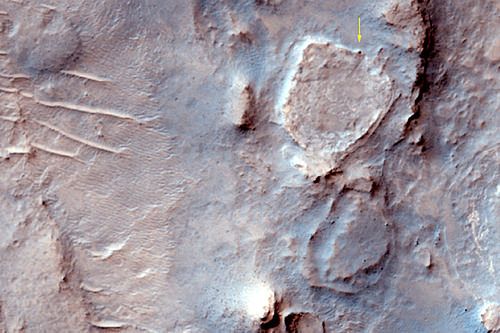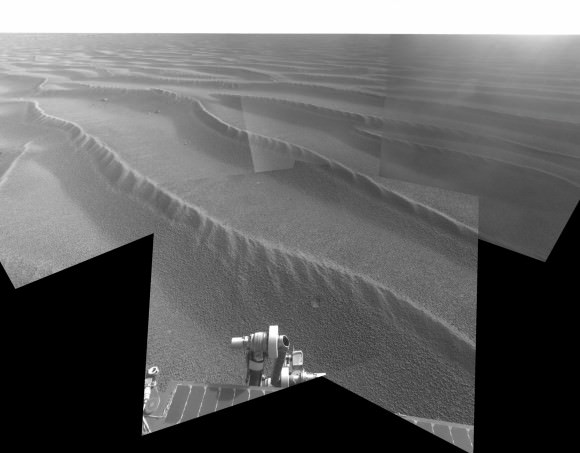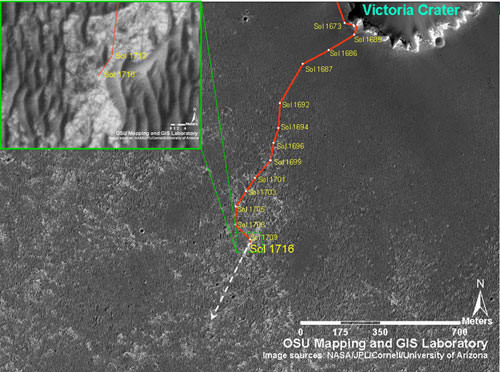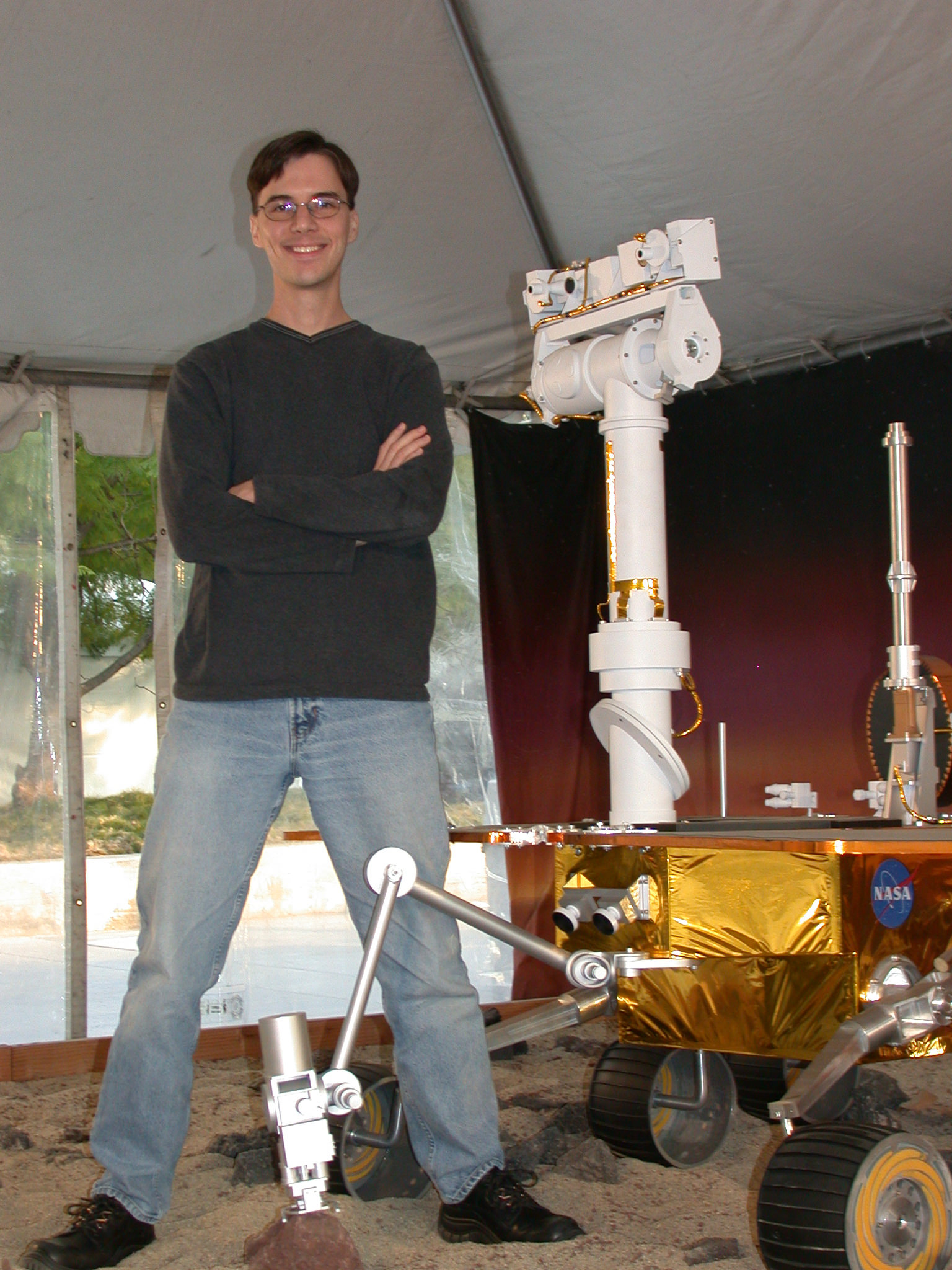[/caption]
In January of 2004, NASA’s twin robot geologists, the Mars Exploration Rovers Spirit and Opportunity, landed on the Red Planet. During those nearly five years, the rovers have returned hundreds of thousands of images and enough data to keep scientists busy for decades. But almost nine years ago, Scott Maxwell started working on developing software and techniques for driving the rovers around on Mars surface. Today he’s the Mars Rover Driver Team Lead for MER at JPL, and he says that every day of working on this mission has been incredible. “It’s been an amazing experience,” he said, “and I like to say it’s the best job on two planets.” To celebrate the upcoming fifth anniversary of the rovers on Mars, Universe Today caught up with Scott to get an update on the current status of the two rovers, to find out what the five-year MER mission has been like for a rover driver, and to ask the pressing question, just how do you drive a rover from 150 million kilometers away?
Both rovers have been inactive recently because of solar conjunction, where the sun is between Earth and Mars, which makes communications difficult because the amount of radio noise generated by the Sun. So, when I talked to Scott on Wednesday of this week he was just working on the commands that would be sent to Spirit for the first drive she has taken since several weeks ago. So how is Spirit doing these days?
“Spirit is struggling valiantly to climb up the north face of Home Plate,” Scott said. “As you know, we’ve just come out of solar conjunction, and so we’re picking up where we left off on Spirit’s climb up the face. Her solar array energy levels are not as good as they were before the mini-dust storm we had before the conjunction, so that’s obviously a cause for concern. It’s unfortunate because that means we have less energy for driving. But she’s still alive and that’s a lot better than what we thought she’d be five years into the mission.”

Home Plate is a low plateau about 80 meters (260 feet) in diameter. Spirit spent the Martian winter parked on the north side of the plateau with her solar panels slanted towards the low sun in order to stay alive. But Spirit’s solar arrays are severely dust-covered, decreasing the amount of power available for science activities and driving. But the scientists and engineers haven’t given up on Spirit, and still have big plans for her.
“Our longer term goal is to head south from Home Plate to a pair of features called ‘Goddard’ and ‘Von Braun’,” said Scott. “Von Braun is a hill and Goddard is a crater-like feature next to it, and that’s the next area we’d like to explore. As you know, the area around home plate appears to be a region of past hot-springs or volcanic fumarole activity, the kind of place where life might have formed on Earth, so it makes it a particularly exciting place to explore on Mars, as we try to find out more about what was going on here.”
But ‘Goddard’ and ‘Von Braun’ are on the south side of Home Plate and Spirit is on the north side. The easiest route would be to “climb back up on the top of Home Plate and kind of skate across it where the driving is good” Scott said, but if Spirit isn’t able to make the climb, they will drive down the north slope and go around Home Plate the long way. But that might take more time, and time might be getting limited for Spirit.

So, the shortest way is up and over Home Plate. But Spirit has a bum right front wheel, and is trying to climb up some difficult terrain. “Imagine you’re in the desert, climbing up a sand dune, but every step you take the sand crumbles out from beneath you,” said Scott. “That’s what Spirit is experiencing. So even though we’re commanding the wheels to go several meters, she might only make a few centimeters of progress in a sol (Martian Day).”
But the driving team will keep trying, as ‘Von Braun’ and ‘Goddard’ are of interest to the science team.
Opportunity, on the other hand, is in very different driving conditions. “Right now she’s basically on a parking lot, with only a couple of speed bumps every once in awhile,” Scott said. “Opportunity can drive 100 meters a sol, like the length of a football field every day, without breaking a sweat. We recently had a nearly record-setting drive, with Opportunity where we drove nearly 216 meters in one day,” Scott said proudly. “So that’s our silver medal drive, our second longest drive ever with either of the rovers.” (The longest drive was 220 meters in one day.)
One thing Opportunity does have to watch out for is sand dunes in the region. In 2005, Opportunity became stuck in one of those dunes, and it took the rover driving team over a month to figure out how to maneuver Opportunity out of the sand trap, called Purgatory Dune. In honor of the difficulties and lessons learned from getting stuck, all the potential sand traps in the region are called “Purgatoids.”

“Opportunity is in a region where Purgatiods are all around her.” Scott said. “But the good news is that we have better data now, than we did when we first encountered these features.” The MER team now has the benefit of the Mars Reconnaissance Orbiter’s HiRISE Camera in orbit around Mars, looking down at — if not watching over – the rovers and their activities. “So we have the data and images from HiRISE, and we think we have identified a way to pick out these Purgatoids from orbit.” Scott said. “So we take the images from MRO, and use them as part of our path planning for Opportunity every day, and also for our longer scale path planning. On top of that we have other measures we have adopted after that first Purgatory incident, where the rover stops every once in awhile and ‘checks’ itself, gauging whether it is actually moving or if it is stuck and the wheels are just spinning. So even if we get into a Purgatoid, we’ll be able to catch it before too long and have the chance to get ourselves out before we dig in too far.”
But so far, with the new technique of being able to identify Purgatoids from orbit, Opportunity hasn’t run into a single one.

“It makes us happy to put the pedal to the metal and just drive,” Scott said, “It’s a lot of fun.”
Opportunity is “putting the hammer down” to reach a crater about 12 kilometers (7 miles) away called Endeavour. The huge crater is 22 kilometers (13.7 miles) across, and scientists expect to see a much deeper stack of rock layers than Opportunity saw while she was in Victoria Crater the past two years. The 12 km driving distance would match the total distance it has traveled from 2004 to mid-2008. Even at the 100-meter plus pace each sol, the journey could take two years.
But Scott Maxwell and the 13 other rover drivers working on the MER mission are up for the challenge.
Tomorrow: Part 2: Just how do you drive a rover on another planet?
How to Drive a Mars Rover, Part 3


@pmf71 We certainly wanted to include some mechanism to clean off the solar panels. Unfortunately, we simply couldn’t get anything working in time, and we’d have had to remove a science instrument in order to make room for such a mechanism anyway. Given that we’re now five years into our three-month mission, with all of the mission’s original goals long since met, it’s hard to argue with that decision.
Also, the arm can’t reach most of the deck, so even if the arm had some dust-cleaning mechanism such as a brush, we’d be able to clear off only a small area at best. (A fan wouldn’t work too well because the Martian atmosphere is so thin.)
It’s a hard problem!
Can I have a go?
You know, i thought they would have included a small soft anti-static brush with long bristles on the rover’s arm to carefully wipe most of the dust off in one or two strokes, i know they can do this without damaging anything else.
Even a small, high revving 1 watt fan would have done the trick. Point and blast kind of thing.
Good work Scott!
These tough ol’ girls just keep rollin’ on.
Ah, the dust…. and it would have been so easy to do something about it… and what a silly oversight…. NOT!
Please let us remember that those little robots “have been at it” TWENTY times longer than expected… and marvel at the fact that they are still “doing things”.
I’m impressed.
BTW: my camera has an ultrasonic vibrator to shake dust off the imaging chip. It uses very little power….. perhaps NASA could get in touch with Olympus about licensing the technology, for developing a larger version? Then again, the next rover doesn’t have solar panels….
Looking forward to you making it to Endeavour crater, hope your team gets there ok.
I know the Venera craft did not last long on Venus all those years ago. But with today’s technology, can we build rovers that would survive on Venus?
Certainly they can include a brush if they have the room and foresight.
How ’bout a rover on Titan? Too cold to function?
Also, it’s time to give up these silly “solar energy” powered rovers. That’s idealism from the seventies.
orrery66 Says:
can we build rovers that would survive on Venus?
A rover for Venus, now that sounds like a challenge, I honestly have no idea if we could build such a thing, but in the search for life on Venus a balloon or fleet of balloons for Venus would be better suited.
KevinM Says:
Also, it’s time to give up these silly “solar energy” powered rovers. That’s idealism from the seventies.
I agree to that statement, nuke powered rovers, so theres no power sharing or having to wait to do something, lots of power to do lots of science.
My wife and I travelled from NZ to watch the Opportunity launch. It was a good thing that we planned for three weeks in Florida, because, instead of launching two nights after we arrived, it finally got away three nights before we flew home. It was a close-run thing and the sight and sound of that glorious rocket rising into a clear night sky will stay with us for the rest of our lives. We have closely followed the career of “our” Rover since then and we are delighted that both of them have endured far beyond their use-by date.